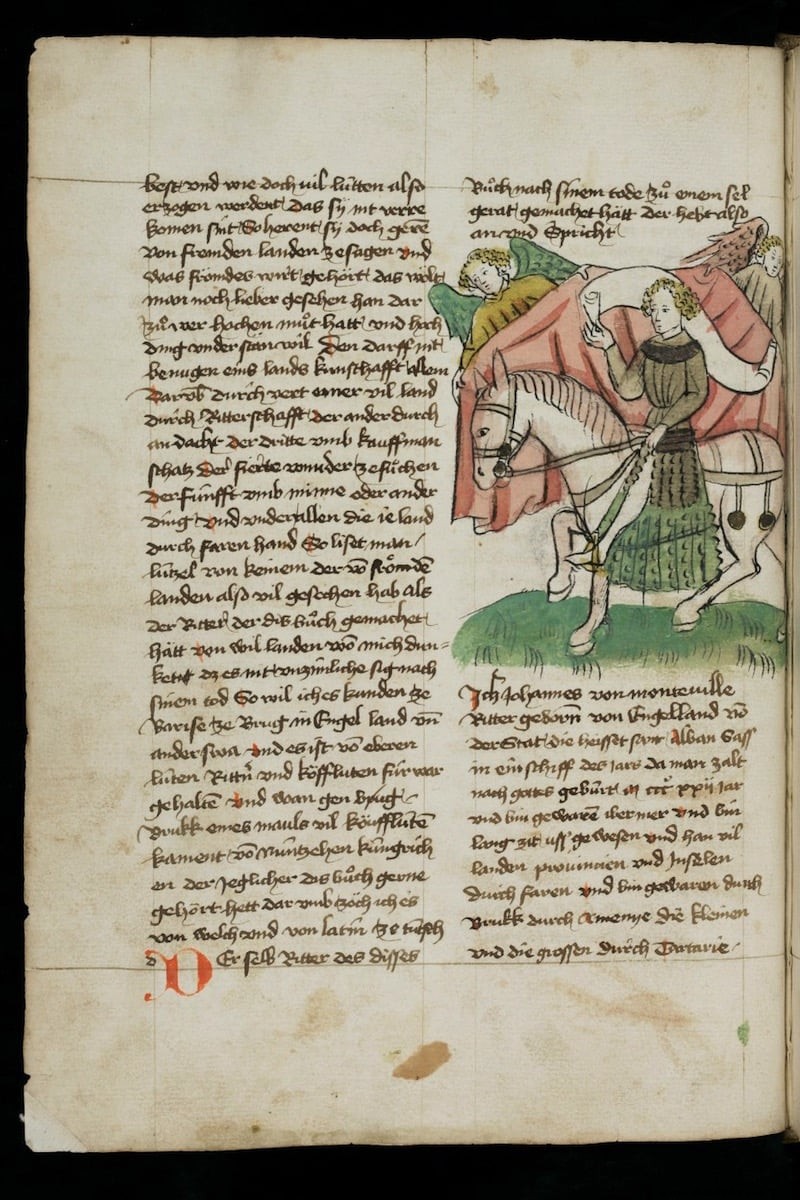The Travels of John de Mandeville It is a medieval book that circulated profusely and with great success throughout Europe between the years 1357 and 1371. Of its author, the supposed Sir John Mandeville, hardly what is related in the book itself is known, and he is considered a character completely fictitious.
The Trips It was very popular in Europe at the time, with translations into many languages. Despite the fact that most of what it recounts are impossible events and voyages of a fantastic nature, it was widely used as a reference book, and even Christopher Columbus had it as one of his bedside works, along with The Book of the Wonders by Marco Polo.
In the preface the author introduces himself as a gentleman born in England in the town of San Albans. Despite the most accepted theories is that in reality it was either the French author Jehan a la Barbe, or Jan de Langhe, a Flemish who wrote in Latin under the name of Johannes Longus and in French as Jean Le Long.
The book recounts how the supposed Juan de Mandeville began his journey in 1322 , passing through Asia Minor, Cilicia, Tartary, Persia, Syria, Arabia, Egypt, Libya, Ethiopia, Chaldea, Amazonia, India, China and, of course, Jerusalem. It has been found that most of the stories are taken from the work of Odorico de Pordenone, but interpolated with annotations, most of the time extravagant, which show that the author barely understood what he was copying.
Unfortunately for Odorico, the fame of Mandeville's Voyages It reached such a point that he ended up being identified as his companion on his travels around the world, and he himself was accused of plagiarism. Mandeville's cheek reaches its zenith when in the text he suggests the possibility of having traveled with Odorico, probably to avoid further criticism.

From the Historiae Orientis de Haitón de Coricos (written in 1307) would have extracted the data that he mentions about the geography and history of Asia. A passage from Marco Polo also appears, although it is thought that he must have found it interpolated in his version of Odorico's work, because if he had had access to Polo's work he would surely have copied more passages.
The story of Prester John is taken from the famous epistle about that imaginary character widely circulated in the thirteenth century. Many fabulous stories of monsters, cyclops, cannibals or the phoenix are taken from Pliny and other later authors, and are mixed with the biblical-mythological stories of the time, such as those of the grains of paradise from which the wood of the cross grew, the Balsam plants of Masariya, the Dragon of Cos or the Sambation River.
Miscopying Wilhem von Boldensele, a German knight who traveled to Egypt and wrote memoirs of him in 1136, Mandeville asserts that the pyramids cannot be tombs , since they are empty inside, but everyone in Egypt knows that they were barns.
It is not very clear, however, if Mandeville traveled to the places he mentions. But the researchers say the appropriation of stories from him didn't necessarily have to be intentional . All the travel stories of the time used the same ancient and contemporary sources, as it was the way to make them believable for the readers.
Why Columbus would have this book as a reference it is explained because Mandeville shows to have a quite correct idea of the shape of the Earth, including knowledge about the latitude derived from the observation of the North star. He also knows the concept of antipodes, and states (in the year 1357) that a ship could sail around the world going East and reach its place of origin again . He also claims that Jerusalem is the center of the world, and as proof he relates that a spear stuck in the ground in the city casts no shadow at noon. If this had been true, it would also have been proof of the sphericity of the Earth, always clear that Jerusalem was located on the Equator.
In Project Guttenberg you can download an English version and in the Internet Archive there are several translations of the Journeys of Juan de Mandeville .
